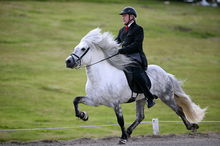Determining the diet that works best for a performance horse is similar to determining what should go into the diet of a human athlete. What, when, and how much is fed is tied to the length and intensity of the work the horse will be asked to do. A trainer preparing a Thoroughbred for a short, explosive sprint on a racetrack will feed quite differently from an owner who is planning to enter her Arabian gelding in a 50-mile endurance race.

Planning for maximum horse power
To determine the type of diet and the pre-exercise feeding schedule that allows horses to perform at optimal levels, it is necessary to balance the horse's requirement for nutrients with its expected performance.
© 2012 by Dagur Brynjolfsson
To determine the type of diet and the pre-exercise feeding schedule that will allow horses to perform at optimal levels, it is necessary to balance the horse’s requirement for nutrients with its expected performance. Those who manage equine diets will be able to make better feeding choices if they understand the basic structure of the horse’s digestive organs and the influence of feeding on blood flow distribution.
The horse’s digestive tract consists of a rather small stomach, a long small intestine, and a large hindgut that holds gallons of fluid and billions of microorganisms that aid in the fermentation of fiber. Much of the weight of the digestive tract is due to this sizeable fluid content. In the idle horse, somewhat more blood flow is sent to the digestive tract organs. When the horse exercises, blood flow to the muscles increases and the supply to support digestion decreases.
The following guidelines have been based on a classification of exercise performance that uses three categories: high intensity/short duration; moderate intensity/medium duration; and low intensity/long duration.
High intensity/short duration exercise
During high intensity/short duration exercise, the horse is working at or near its maximum heart rate. The horse can maintain performance at this level of exertion for only a short period of time (less than 10 minutes). One example of this type of exercise is flat-track racing.
Due to the short duration of this exercise, it is generally thought that nutrients needed to fuel muscle contraction must be stored in the muscle prior to exercise. Therefore, feeding horses with the intention of loading the blood with nutrients to be metabolized during short-term exercise does not appear beneficial.
In fact, studies at Kentucky Equine Research (KER) have shown that feeding grain within four hours of submaximal exercise caused large declines in blood glucose during exercise. These declines in blood sugar may be detrimental to exercise performance since glucose is the only fuel metabolized by the central nervous system.
Feeding large fiber meals prior to exercise is not warranted either, because fiber would increase the body weight carried by the horse, slowing its pace. Racing officials routinely handicap horses by assigning additional weight to superior runners.
If racing officials can potentially change the outcome of a race by assigning as little as 4 lb, what would be the impact of a short-term fast (12 hours) on body weight? Longer periods of fasting would further decrease body weight; however, potential problems including digestive upset may occur with refeeding these horses.
Feeding recommendations for high intensity/short duration exercise:
Hay feeding - eliminate 12 hours prior to exercise
Grain feeding - do not feed within eight hours of exercise
Water - no restrictions
Moderate intensity/medium duration exercise
During moderate intensity/medium duration exercise, the horse is working at a heart rate between 50% and 75% of maximum. Exercise of this intensity may be tolerated for several hours. This type of exercise may include a variety of show events in which horses perform in a number of classes throughout the day.
Since speed is not the primary concern, the weight of the animal does not appear to be critical. These horses would benefit from small, frequent forage meals, which also serve to eliminate boredom. Grain meals should be avoided within eight hours of performance. This would eliminate the large fluctuations in blood glucose associated with feeding and postprandial exercise.
Feeding directions for moderate intensity/medium duration exercise:
Hay feeding – small, frequent meals; avoid large single meals
Grain feeding - eliminate grain within eight hours of exercise
Water - no restrictions
Low intensity/long duration exercise
During low intensity/long duration exercise the horse is typically working at less than 50% of heart rate maximum. At this intensity, exercise can be tolerated all day. Trail riding and some endurance rides are examples of this type of exercise.
These horses have increased requirements for water and electrolytes due to the duration of exercise. They would benefit from the water-and electrolyte-holding characteristics of high-fiber diets. The fiber should be of high quality so that fermentation can occur, thereby making these nutrients available for absorption. The use of super fibers including soybean hulls and beet pulp is warranted due to their high fermentation and water-holding capacity.
Meals provided during the ride should also maximize forage consumption since forage will stimulate water intake and help maintain hydration. Grain intake should be minimized during the ride in an effort to avoid fluctuations in blood sugar.
Dietary fat is recommended to increase the energy density of the diet and to decrease the amount of grain needed in the diet. Horses performing at this level of exercise will benefit from electrolyte supplementation as needed to replace the electrolytes lost in sweat.
Feeding recommendations for low intensity/long duration exercise:
Hay feeding - free access to high-quality forage (high digestible fiber, low crude protein content)
Grain feeding - eliminate or minimize during day of the ride
Water - no restrictions
Information for news item from Kentucky Equine Research Publication
